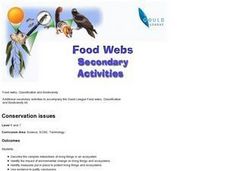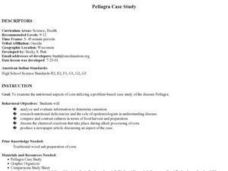Alabama Learning Exchange
The Water Cycle
Young scholars participate in a hands-on experience with the water cycle. They experience different parts of the water cycle through experiments and exploring the Internet. They create a poster or model of the water cycle and explain...
Curated OER
Earth Water Distribution and Water Consumption
Young scholars explore the need for conserving fresh water and understand that it is a limited supply. In this water consumption lesson plan students participate in an activity and answer questions.
Curated OER
Debating for Land
Students research pertinent information based on historical facts and is supported by quotations from primary sources in order to prepare for a class debate about land ownership in the 19th century.
Curated OER
A SALT WATER-Y WORLD
Students observe a model of the distribution of the earth's water and compare the relative volumes and percentages of types of water on earth.
Curated OER
Who Works for Nonprofit Organizations?
Students research nonprofit jobs. In this nonprofit organizations lesson, students brainstorm jobs available at nonprofit organizations and listen to guest speakers talk about working for a nonprofit organization. Students focus on one...
Curated OER
Soil Sample Lab
Students test the pH of soil samples they collected from the field trip. In this chemistry lesson, students differentiate acids and bases. They write a lab report about the experiment.
Curated OER
Where's the Point?
Pupils examine runoff for the causes, the impact, and the solution. For this investigative lesson students construct a three dimensional model of a watershed and provide information of contaminated runoff to their audience.
Curated OER
Unfold the Mystery of Mold
Learners research the conditions in which molds thrive. They apply the scientific method to develop a hypothesis, conduct research and test results.
Curated OER
Habitat Is Home
Pupils are introduced to the concept and components of a habitat. They discuss the key components of a habitat and describe how certain factors can cause disturbances in a habitat and change its population. Activities are leveled for...
Curated OER
Conservation Issues
Students discover the relationship among living things in an ecosystem. They identify the impact of environmental changes on animals and how to protect them. They work together to create an informational brochure.
Curated OER
Water Quality Monitoring
Students comprehend the four parameters of water quality. They perform tests for salinity, dissolved oxygen, pH and clarity or turbidity. Students comprehend why scientists and environmental managers monitor water uality and aquatic...
Curated OER
Where is Oil Found?
Students determine that crude oil is found in porous rocks (reservoirs) rather than in caves or caverns.
Curated OER
Pellagra Case Study
Students examine a case study documenting the experience of three teens in the 1920's era with a disease (Pellagra) which was prevalent throughout the United States, most particularly in persons with a corn based diet. They create a...
Curated OER
Enzymes in Action: An Inquiry Approach to the Effects of Enzymes
Students experiment with enzymes as key components of chemical reactions in all living things through this series of lessons.
Curated OER
How Do You Know There is Air in a Bag?
Fourth graders explore air as a material substance. Through experimentation and discussion, they explore how air can be classified as a material substance. Students write three examples proving that air is a material substance in their...
















